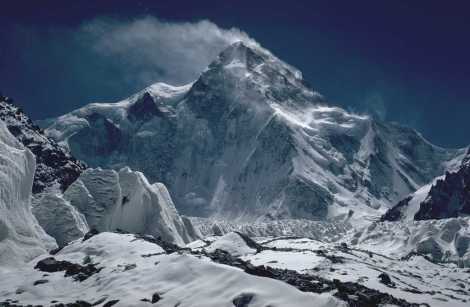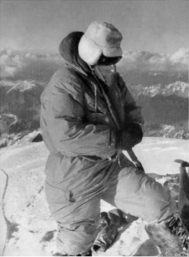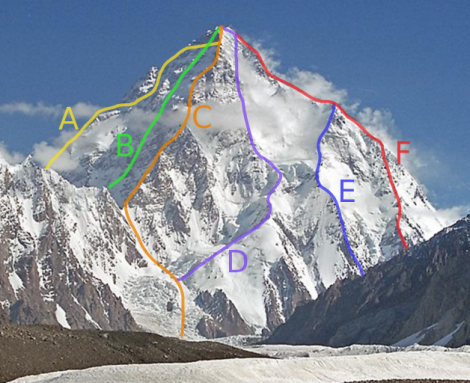Everest may be on every mountaineer’s bucket list, but true mountaineers know the prize lies on the summit of K2, or Karakoram 2; the savage mountain, the brutal mountain, the “King of Mountains.” At just 800 ft. (243.8 m) shorter than Everest, K2 is the world’s second highest mountain. While Everest is the tallest, it does not compare in any measure to the brutality that is an expedition on K2.

Image Credit: Kuno Lechner | License
K2 is quite often called “The Mountaineers’ Mountain,” and that’s because the arduous task of climbing it requires every technical skill a mountaineer has learned over the course of their lifetime.
Why is it Called K2?
The incredible story of K2 is ironic in the sense that, for such a fearsome and famous mountain, it literally has no name. K2 was dubbed “Karakoram 2” in 1856 by a young Lieutenant by the name of T.G. Montgomerie while he stood on Mount Haramukh. His simple sketch detailed the two most prominent peaks of the Karakoram range as “K1” and “K2,” “K” standing for the Karakoram. After that survey, the names just stuck.
While K2 never got an official name, it did have a native name, Chhogori, which means “king of mountains.” It seems even the natives were aware of its awesome power before anyone had ever attempted to climb it and report back on it.

Montgomerie’s original sketch in which he applied the notation “K2.”

Achille Compagnoni on K2’s summit on the first ascent (31 July 1954)
K2 is a highly technical mountain; climbing it is not about whether or not you can trek your way to the top like Everest. It’s about whether or not you can even make it past its rugged base and continue up the path of what seems like climbing a guarded gulag of sharp rocks and ultra steep walls. K2 is not a mountain to be conquered, but a mountain that rips your soul from you and hangs it over the summit, forcing you to reach its peak to retrieve it.
Those who fail, either never make it back or return with unbearably unsatiated appetites for what was never to be. Most who make an expedition to K2 and don’t reach the top find themselves coming back tirelessly as if they’ve left their very soul on the mountain. For some, that tenacity costs them their very lives.
Routes up to K2’s Summit

Image Credit: Kogo Wiki | License
Even so, trailblazers have carved routes through the mountain which are still in use today. Mountaineers usually take one of ten pre-determined routes to the peak.
The Abruzzi Spur Route on K2 (F)
The Abruzzi Spur is K2’s go-to route, with 75 percent of climbers tackling this pass that is located on the Pakistan side of the mountain. This route gets its name from Prince Luigi Amedeo, Duke of the Abruzzi who first attempted to summit K2 through it in 1909.
This route passes along “House’s Chimney and “The Black Pyramid.” These locations are some of the mountain’s most technical climbs. Abruzzi also shuffles climbers up the “Bottleneck,” which is located just to the left of dangerous seracs. The Bottleneck has a history. It was here that in 2008 a series of accidents lead to the deaths of 11 climbers in an event known as the 2008 K2 Tragedy.
The North Ridge Route on K2
The North Ridge can be called the most dangerous route to the summit of K2, with, at most, two teams daring the attempt at a time. This route is accessed via the Chinese side of the mountain, passing some of the most technical areas of the mountain.
The Northeast Ridge Route on K2
This route finishes on the uppermost part of the Abruzzi route – the route was first climbed by an American team of four climbers in 1978
The West Ridge Route on K2 (A)
The West Ridge Route of K2 begins further away at Base Camp and on the Negrotto Glacier; it was first climbed in 1981. the technical aspects of this climb include traversing an unpredictable landscape of rocks and snowfields and setting fixed ropes through the West Face.
The Southwest Pillar (Magic Line) Route on K2 (C)
The Southwest Pillar Route is a technically challenging route considered to be the second most demanding. It was first climbed in 1986 by a Polish-Slovak expedition. The only other known successful attempt to climb this route was accomplished by Jordi Corominas of Spain in 2004.
Legendary mountaineer Reinhold Messner reportedly viewed this route and called it “suicidal” in 1979 and chose to ascend via the Abruzzi Spur instead. It is accessed via the Pakistan side and features some of the mountain’s steepest sections full of icy rock.
The South Face (Polish Line, Central Rib) Route on K2 (D)
The Southe Face Route of K2 is the most dangerous and demanding of all. It was first climbed in 1986 by Jerzy Kukucka and Tadeusz Piotrowski, who was killed on the descent. Entrance to this route is via the Pakistan side, and it starts off the first part of the Southwest Pillar before deviating into a highly exposed, snowy cliff area.
This route proceeds through a gully, “The Hockey Stick,” and rises through another completely exposed cliff-face. From here, climbers are met with more exposed terrain before it meets up with the Abruzzi Spur 1,000 feet before the summit. The route is very avalanche prone, which is partly why no one has ever attempted another summit via this route.
The Northwest Face Route on K2
The Northwest Face Route of K2 was first ascended in 1990 by a Japanese team. Access to this route is via the Chinese side and begins at K2 Glacier where it then climbs the Northwest Ridge before it turns through the rugged, rocky and snowy terrain of the Northwest Face all the way to the summit.
The Northwest Ridge Route on K2
The Northwest Ridge Route of K2 was first ascended in 1991 and it finishes on the North Ridge.
South-Southeast Spur (Cesen Route) (E)
The South-Southeast Spur Route was first ascended in 1994 by a Spanish-Basque team. Access to this route is via the Pakistan side of the mountain, and it is considered to be the safest way to the summit because it avoids Black Pyramid, the first big obstacle on the Abruzzi Spur. It connects with the Abruzzi Spur about two-thirds of the way up the mountain.
After the 2008 K2 Disaster, Fredrik Sträng didn’t return to attempt the summit until 2017, almost a decade later. His expedition in 2017 did not yield a summit. When the expedition was almost over, he attempted the summit via the Cesen Route, but could not reach the summit this way either.
The West Face (B)
The West Face Route of K2 is a technically challenging route. It was first ascended in 2007 by a Russian team, and it is almost entirely comprised of rock crevasses and snow-capped couloirs.
The Power of K2
The devastating power of K2 hangs over the mountain unlike any other, with constant clouds and muggy weather. Like most mountains its size, K2 sports its own weather system. But unlike Everest, catching a clear day here is God’s honest luck. Even a clear day on K2 can turn into a tragedy at the turn of the wind’s direction. This was the case on August 01, 2008 when the single most devastating series of events occurred on the mountain. Eleven climbers from international expeditions lost their lives on a day that started out perfect and ended in what seemed like a neverending death trap at every turn.
K2 is neither a forgiving mountain nor a welcoming one; people don’t belong there, and the mountain makes sure to get that message across to those who dare scale its back. But if there’s anything to be said about humans, it’s that we rarely accept nature’s rules, and there are few places we believe we don’t belong. And that’s a good thing. That same psychological behavior we all share has been responsible for some of the mountaineering world’s greatest feats.
The routes up K2 are often called “technically challenging,” but that’s an understatement when compared to other mountains. The routes themselves are miniature testaments to the sheer awesomeness that is the entire technical prowess of K2 – the mountain itself is one enormous technical monster. Compared to K2, Everest is literally a walk/trek to the summit.
Deaths on K2
By the measure of ratio, the death count on K2 is much higher than that of Everest, with well-documented mountaineering disasters in 1986, 1995 and the most recent in 2008. The 2008 disaster has been known as the most controversial of all.
For every 100 mountaineers that attempt a summit on K2, 29 will die. Only 306 climbers have succeeded, 80+ have perished. Compared to Everest’s 5600+ summits and around 300 deaths, K2’s reputation, which is all but impossible to describe in words, is accurately captured by something as simple as numbers.
Sources:
Publishing Team, K2. “The Climb (K2).” K2Climb.net. K2 Climb, 2005. Web. 25 Dec. 2016. <http://www.k2climb.net/expguide/route.shtml>.
Chhoghori, K2. “K2 Chhoghori The King of Karakoram”. Skardu.pk. Retrieved 23 November 2016
Messner, Reinhold, and Alessandro Gogna. Trans. A. Salked. K2 Mountain of Mountains. Oxford: Oxford UP, 1981. N. pag. Print.

Pingback: K2 Mountaineering Documentaries You Can Watch on YouTube | Base Camp Magazine·
I am sure this piece of writing has touched all the internet
users, its really really pleasant piece of writing.
LikeLiked by 1 person
Thank you Jane, we strive to bring good mountaineering stories and content to out readers.
LikeLike
Just a trekk uphill Everest!? I’m wondering what Huston, The Villain and Bonington would say about that. Are you really a mountaineer…?
LikeLike
Haston, sorry.
LikeLike
Pingback: What Are the Seven Summits? | Base Camp Magazine·
Pingback: Routes Up to K2’s Summit | Base Camp Magazine·
Pingback: Ultimate Food Supply List for Climbing K2 | Base Camp Magazine·
Pingback: Editor’s Note: K22017 | Base Camp Magazine·
Good write-up. I certainly love this site. Keep it up!
LikeLiked by 1 person
Pingback: July 2017 Features on Base Camp Magazine | Base Camp Magazine·
Pingback: Fredrik Sträng Reaches Paju and First Sight of K2 | Base Camp Magazine·
Pingback: Remembering Alberto Zerain | Base Camp Magazine·
Pingback: First Successful Summits on K2 Since 2014 | Base Camp Magazine·
Pingback: The 2008 K2 Tragedy | Base Camp Magazine·
Pingback: K2 Remains Unconquered in Winter | Base Camp Magazine·
Pingback: The Seven Summits According to Messner | Base Camp Magazine·
Pingback: K2 Mountaineering Documentaries You Can Watch on YouTube | Base Camp Magazine·
Pingback: Routes Up to K2’s Summit | Base Camp Magazine·
Pingback: Alex Txikon Reaches Camp 1 on K2 | Base Camp Magazine·
Pingback: Fredrik Sträng Arrives in Skardu Ready for K2 | Base Camp Magazine·
Pingback: Fredrik Sträng Finally Reaches K2 Base Camp | Base Camp Magazine·
Pingback: The Seven Summits According to Richard Bass | Base Camp Magazine·
Pingback: Remembering Tom Ballard: A Light Extinguished | Base Camp Magazine·
Pingback: Must-read Books About Climbing Disasters | Base Camp Magazine·
Pingback: How to be Appealing to Expedition Sponsors | Base Camp Magazine·
Pingback: What Are the Seven Summits? | Base Camp Magazine·
Pingback: K2 Winter 2020 Dispatches: Apricot Tours Heads Out Led by Mingma G. | Base Camp Magazine·
Pingback: Dispatch: Apricot Tours K2 Winter 2020: On the Way to Askole | Base Camp Magazine·
Pingback: A Sore Neck, Wet Snow and a Taste of Camp 1 for Fredrik Sträng | K2 2017 | Base Camp Magazine·
Pingback: Dispatch: Arrival at K2 Base Camp: Apricot Tours K2 Winter 2020 | Base Camp Magazine·
Pingback: The Climb to Camp 2 | K2 2017 | Base Camp Magazine·
Pingback: The Wait is Over, Fredrik Sträng Attempts K2 Summit Today | Base Camp Magazine·
Pingback: K2 2017 is Over, Fredrik Sträng to Try Again Next Year | Base Camp Magazine·
Pingback: Routs up to K2’s Summit - The K2 Adventure·